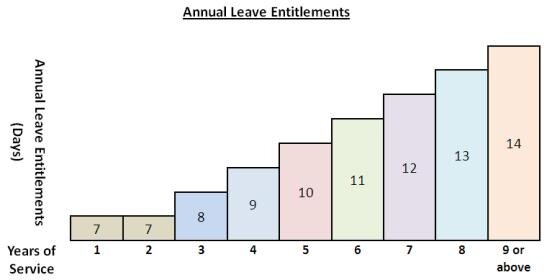How many days of paid annual leave should be granted to an employee? Can an employer make payment to an employee in lieu of annual leave?
Labour DepartmentEligibility for Paid Annual Leave
According to the Employment Ordinance, an employee is entitled to annual leave with pay after having been employed under a continuous contract for every 12 months. An employee's entitlement to paid annual leave increases progressively from seven days to a maximum of 14 days according to his/her length of service:

(click the above for the enlarged chart)
An employer who without reasonable excuse fails to grant annual leave to an employee is liable to prosecution and, upon conviction, to a fine of $50,000.
Granting of Paid Annual Leave
An employee shall take the paid annual leave to which he is entitled within the following period of 12 months*. The time of the leave should be appointed by the employer after consultation with the employee or his representative, confirmed by a written notice to the employee at least 14 days in advance, unless a shorter period has been mutually agreed.
*If an employer adopts common leave year for all of his employees, even if an employee has not been employed for 12 months in the common leave year, the employer should calculate his leave entitlement on a pro rata basis.
Paid annual leave should be granted for an unbroken period. If the employee so requests, it may be granted in the following manner:
|
Annual Leave Pay
Calculation of Annual Leave Pay
The daily rate of annual leave pay is a sum equivalent to the average daily wages earned by an employee in the 12-month period preceding the following specified dates. If an employee is employed for less than 12 months, the calculation shall be based on the shorter period.
|
Note: When calculating the average daily wages, an employer has to exclude (i) the periods for which an employee is not paid his/her wages or full wages, including rest day, statutory holiday, annual leave, sickness day, maternity leave, sick leave due to work injuries or leave taken with the agreement of the employer, and any normal working day on which the employee is not provided by the employer with work; together with; (ii) the sum paid to the employee for such periods. Please click this link to information on “ A Concise Guide to the Employment Ordinance - Appendix 2” (PDF).
Time Limit for Payment of Annual Leave Pay
Annual leave pay should be paid to the employee not later than the normal pay day after the period of annual leave taken. An employer who fails to pay annual leave pay to an employee is liable to prosecution and, upon conviction, to a fine of $50,000.
Restriction on Pay in lieu of Leave
An employee may choose to accept payment in lieu of the part of his/her leave entitlement which exceeds 10 days.
|
The is not a legal document. The Ordinance remains the sole authority for the provisions of the law explained.
 Want to learn more?
Want to learn more?










